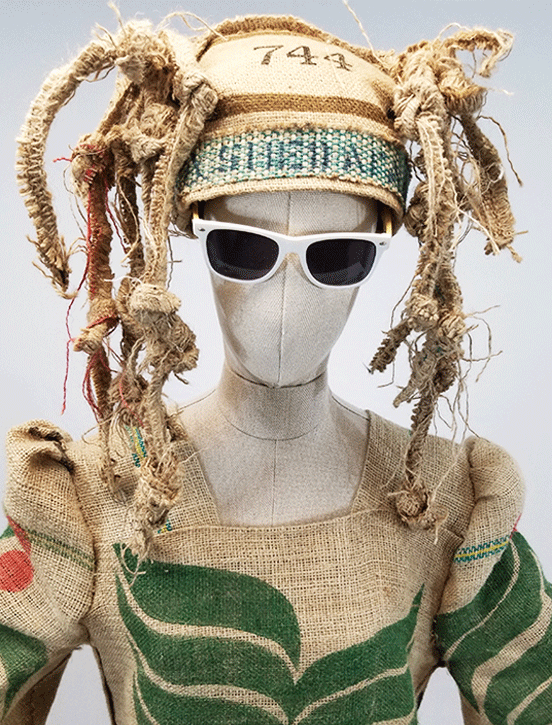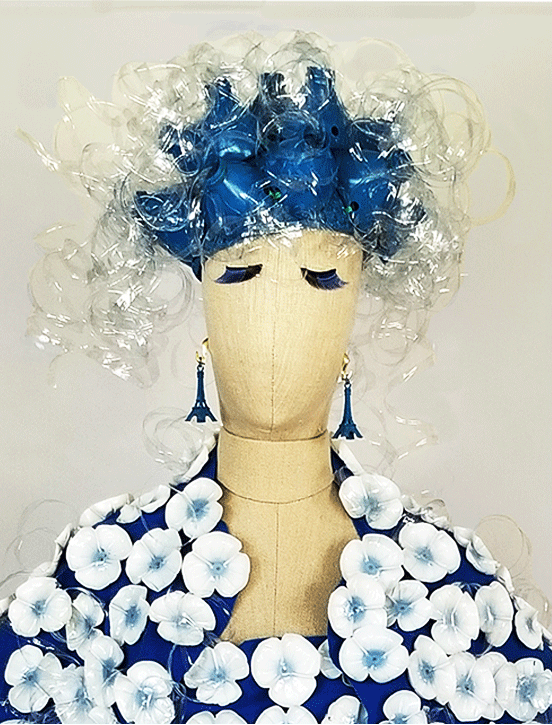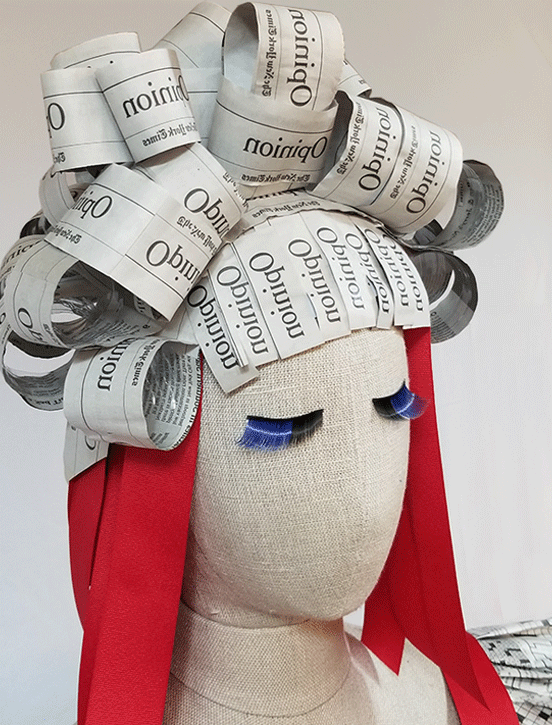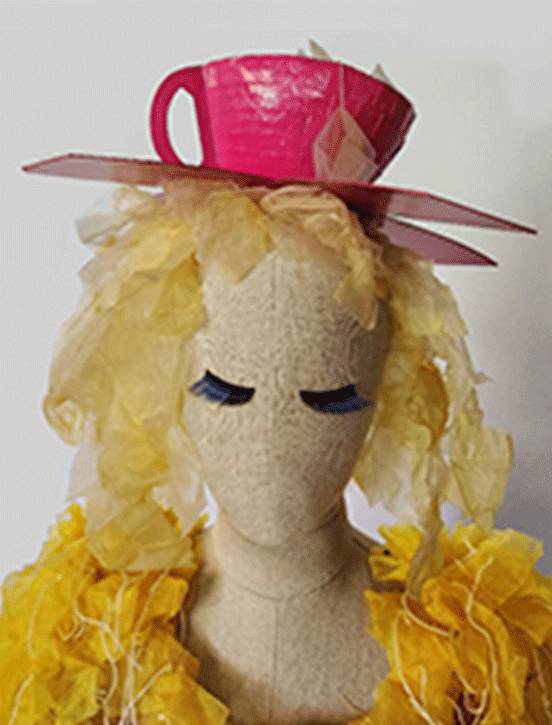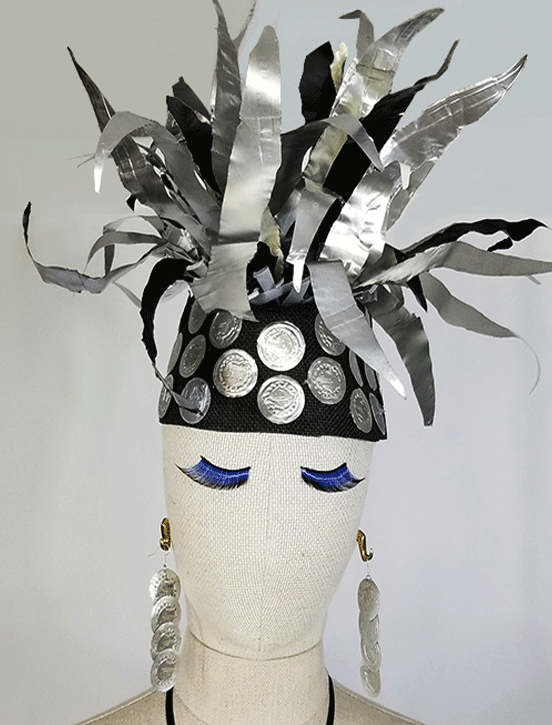 An excerpt from J.L. Rainey’s Journal, Selma, Alabama, March 1965, from the novel, The Clock Of Life, by Nancy Klann-Moren.
An excerpt from J.L. Rainey’s Journal, Selma, Alabama, March 1965, from the novel, The Clock Of Life, by Nancy Klann-Moren.
My posts will include both J.L.’s journal entries, and actual articles from The Selma Times-Journal each day until he reaches Montgomery.
This was day two after he arrived in Selma to take part in the right-to-vote march to Montgomery, forever known as “Bloody Sunday.”
Bloody Sunday, Mar 7, a day I’ll never forget―hopefully, a day no one will ever forget ― Written Mar 8, 11am.
I want to get as much of this down as I can remember. Yesterday started out calm enough and ended up in a clusterfuck. We met at Brown Chapel in the a.m. A huge crowd, maybe 600 of us, eager to make history. Friends among strangers, brothers in the cause ―ignorant as sitting ducks. Around 3 p.m. Lewis and Williams gathered us. First we knelt and prayed, then they led the way for what we thought was to be a five-day march to Montgomery.
****Hosea Williams SCLC and John Lewis, SNCC―two true heroes. One day I’m going to work with them.
Starting out, I had the sense something was off. The streets felt eerie. No police in sight. We marched double file, not much talking going on, just the sound of shoes scuffing. My chest swelled with the meaning of what we were doing.
But when we got to the highest part of the bridge, the marchers in front had stopped. Spam pointed. Beyond the marchers up front was a wall of Alabama troopers in blue helmets waiting. Behind them was a whole mess of douchebags waving confederate flags. Someone might have known, but us peons had no idea Gov. Wallace ordered the march to be stopped. Hell, he probably ordered them to beat us, too.
The troopers charged up the bridge and everything went to hell. The poor saps up front had no choice but turn around and jam against the rest of us. Everything happened like a blur. Just writing about it kicks my adrenalin into high gear, and I’m pissed as hell all over again. I’m sure I’ll remember more later, but a little girl ran past, out of nowhere, then the fumes hit me. My nose first, then eyes. I couldn’t get air in my lungs. They burned like a motherfucker. All I could hear were screams and people gasping from the tear gas. I ran for the girl and picked her up to get her out of the way, but had to let her go when one of the douchebags, a shit-bastard on horseback, started to beat me with a rubber hose wrapped in barbed wire. He wouldn’t let up. The horse reared, its hoof hit my arm, and the man kept right on pounding on me. I crouched to the wet pavement. Wet with blood. Mine. Spam tried to pull me away but got hit, too.
I passed out and woke up in another stinking cell, dried blood all over me. None of the authorities gave a shit. After they released me, three of the marchers put me in the back of their station wagon and got me to Good Samaritan. Waited five hours before getting sewn up―16 stitches on my head and 47 to the shoulder. I’m sorer than I’ve ever been in my life, and bruised, and proud. Damn proud. BLOODY SUNDAY PROUD!
Spam’s ok, but some 50 + were beaten pretty bad, including John Lewis.
****Sheriff Jim Clark. A name to remember. The worst of the worst. The face of evil.
Mon, Mar 8, 4 pm ― Haven’t moved off Spam’s couch all day (it’s my bed, too). Still in shock about yesterday, playing it over and over in my head. Still sore as hell. Shoulder’s still throbbing like a mother, even with a double dose of codeine. Still proud, and still pissed. Nonviolence, my ass.
Wanted to tell Cassie about the biggest day of my life so far. Tell her how much I miss her and wish she was here too, but I’ll have to walk a couple blocks to a phone booth because Spam doesn’t have one. Maybe tomorrow.
Mon, Mar 8, 9 pm ― Found out Spam’s real name is Arnold Jefferson Monroe. How about that for a name—a traitor and two presidents. And I came to understand the reason for his nickname, and the extra 45 pounds. Spam and eggs for breakfast, a deviled Spam sandwich for lunch, then Spamburgers and Southern Comfort for dinner.
We ate in front of the TV and watched the lead story on the NATIONAL news. Our story! Right there on TV we watched the whole mess. Heard the screams. Saw the horses stampede, and the smoke so thick it looked like footage of a war. My lungs burned again, just watching. Then, lo-and-behold, I saw myself getting clubbed. I’d worried about the little girl, and just about cheered when I saw a man pick her up and run with her. We switched from ABC to NBC to CBS and back again.
Spam and I passed the whiskey between us and celebrated like the march was a success. Then it dawned on me that Cassie probably watched me being clobbered on TV. Signing off to find that pay phone.
P.S.
Cassie saw the news. Wants me to come back NOW, but that ain’t going to happen.
The next afternoon, March 8, 1965, the Selma-Times Journal reported:

Civil Rights Leader Will Seek Sanction Of Court For March:
An aide of Dr. Martin Luther King, Jr. said the civil rights leader will come to Selma today to address a mass meeting tonight and to lead a second attempt by Negroes to march Tuesday from Selma to the state capital in Montgomery. “We can’t turn back now.” Rev. Andrew Young said after yesterday’s melee, “We’ll file some papers in federal court Monday and then try to march again Tuesday.
Fifty-six Negroes were sent to the hospital with an assortment of injuries Sunday after state troopers and sheriff’s possemen used tear gas, night sticks and horses to disperse more than 600 Negro marchers who ignored orders to disperse.
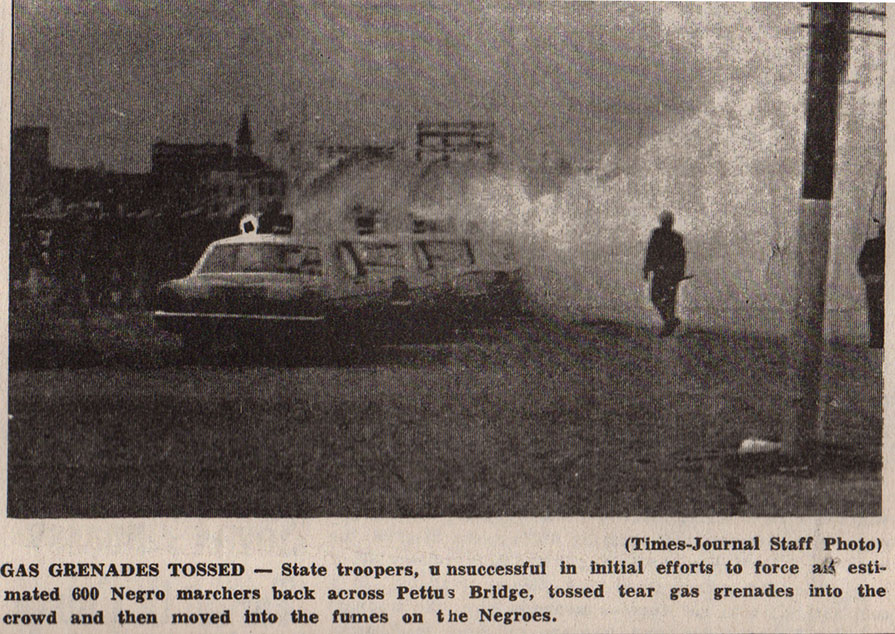
No attempt was made to arrest the group in the violent confrontation at the east end of Pettus Bridge.
When they showed no inclination to obey Trooper Major John Cloud’s order to disperse, an estimated 100 troopers and possemen wearing gas masks stormed into the marchers and shoved, gassed, and beat them back onto the bridge. Horseback riding possemen, and troopers on foot, drove the Negroes across the bridge and herded them back to Brown’s Chapel in a route punctuated by sporadic clubbing and jabbing.
A brief outbreak of missile throwing by Negroes at the state and county officers who drove the Negroes back to the church was followed by a mop-up operation which cleared the George Washington Carver Homes housing development of everyone on the streets. Troopers left their cars and armed themselves with shotguns and automatic rifles and moved through the project with Sheriff Jim Clark and his posse ordering everyone indoors.
At the Jeff Davis-Sylvan Street intersection possemen again used their clubs and tear gas in a brief skirmish with Negroes who shouted taunts at them. Sheriff Clark said one of the Negroes displayed a knife and then ran into a house, necessitating the use of gas to evict him.
When all of the Negroes were driven back into the housing project, troopers and the sheriff’s department stood back and permitted ambulances to haul away the injured.

After they were cleared out, officers moved in to clear the sidewalks and lawns around the two-story apartment buildings.
As the heavily armed state and county officers took over city police jurisdiction over the protests of Selma Public Safety Director Wilson Baker, the city law enforcement supervisor ordered his force to evacuate the area. Moments earlier, in the exchange between Baker and Sheriff Clark, Baker told the sheriff that quiet had already been restored in the Negro community and he saw no need for any further show of force by troopers and the posse.
“I’ve already waited a month too damn long about moving in,” the sheriff retorted. About 30 minutes later, when the sheriff’s force and the troopers pulled out, city police moved back into the area and resumed normal police work.
James Bevel, addressing a mass rally that followed the march, criticized President Johnson for, “Not fulfilling his promises. Johnson knows that Negroes cannot vote here,” he said.
In Atlanta, King said that in light of Sunday’s “tragic event” that he has “no alternative but to recommend to my close associates and the Negro people of Alabama to continue in their determined attempt to walk to Montgomery.”
King had said earlier that he would lead Sunday’s march and his failure to appear and take part in it prompted ridicule for the Negro leader from Mayor Joe Smitherman. “It should be very evident to the Negro people by now that King and the other leaders who ask them to break the laws are always absent from the violence as he was today,” the mayor noted.
Baker who disagreed sharply with the policing of yesterday’s march attempt, planned Saturday night to submit his resignation as public safety director today to city council.
Mayer Smitherman, after privately making agreements with county and state officials with which Baker did not agree, ordered the public safety director to use city police in helping the troopers break up the march. Baker, who maintained that the Negroes should be arrested instead of gassed and beaten, if they refused to disperse, said he would resign rather than carry out the mayor’s orders.
But, when some city council members learned of his plans, they intervened, and an agreement was worked out whereby the mayor, except for establishing policy, would leave city law enforcement planning and supervision to Baker in the future.
After the Sunday meeting, it also was agreed that city police would not participate, unless they were called in by the state, in breaking up the Sunday march. Police had one car on the scene across the bridge to operate as liaison in this connection.
State troopers and county forces agreed under the arrangement, it was reported, that once the Negroes were driven back across the bridge that city police would be in charge of the return of the marchers to the church. When this reported agreement was violated and the troopers and posse pressed the Negroes across town and into the housing development, Baker ordered his men to temporarily pull back. Baker said he wanted to halt the marchers as they left the city and arrest them at Broad Street if they refused to return to the church, but the mayor asked him not to interfere in the state’s plans to break up the march with gas and force.
Mayor Smiterman said later last night on a television show interview that, as mayor of Selma, he “concurred” with the governor’s actions in halting the march.
The marchers made their initial attempt to leave Brown Chapel around 1:30 p.m. Sunday and were turned back by city police less than a block from the church. But it was immediately apparent that the temporary delay was for regrouping and that they would come out again. When the marchers neared the bridge traffic was halted at Water Avenue and at the King’s Bend Road―Highway 80 intersection across the bridge.
Hundreds of spectators jammed all unrestricted parking space and overflowed onto the parking areas of businesses in the Selmont area where the confrontation was to take place. State troopers, their cars lined up alongside the highway from the traffic light to the foot of the bridge, stood waiting while possemen between the buildings awaited orders to mount their horses. When the marchers were within about 100 yards of where Maj. Cloud, Sheriff Clark and a line of troopers blocked the highway, orders were given for the officers to put on their gas masks.
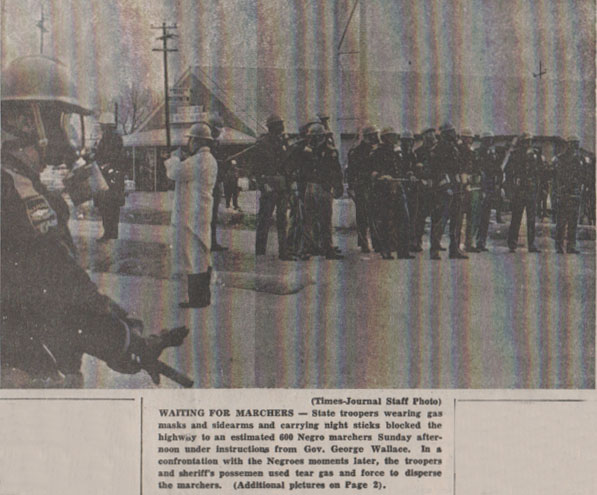
Newsman were told to assemble in front of the Lehman Pontiac building and were assigned several troopers for their protection, “if you obey the ground rules.”
Col. Al Lingo watched from an automobile parked nearby.
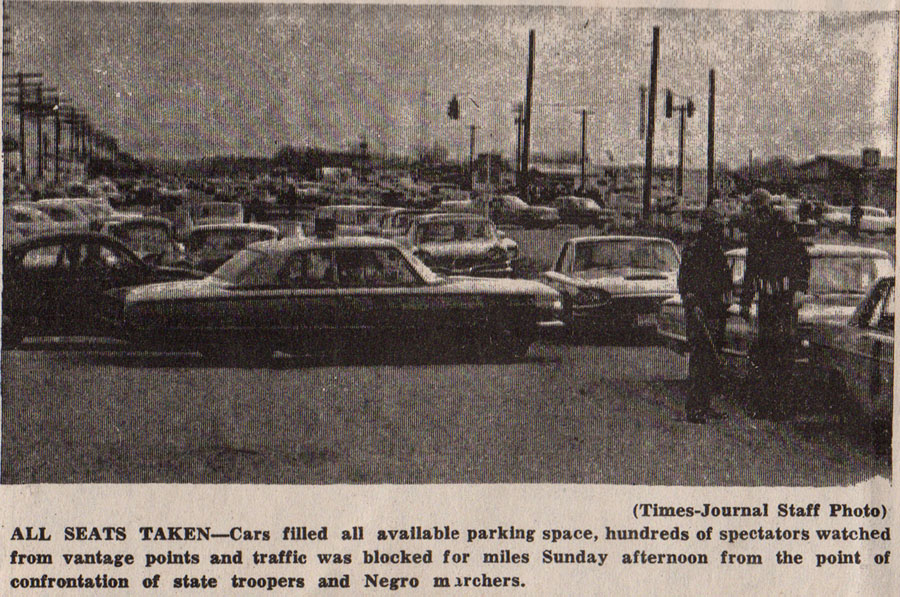
When the marchers were within about 75 feet of where the troopers blocked the highway, Maj. Cloud gave the order for them to halt and disperse.
He told them the march would not continue and for them to disperse and go to their homes or back to the church. When the Negroes failed to withdraw, Cloud ordered “troopers forward.”
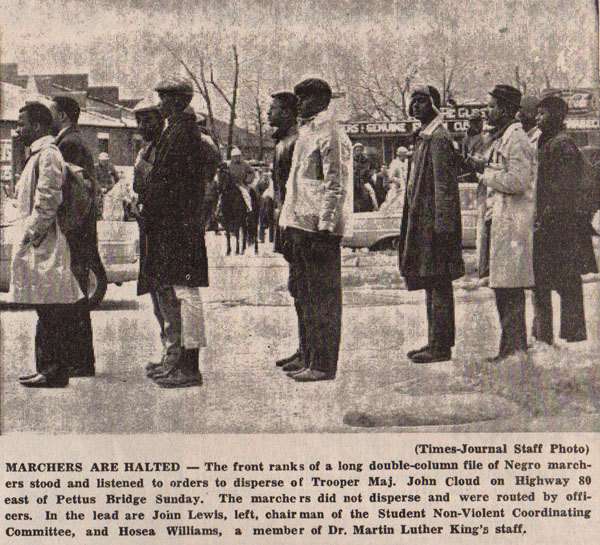
For a few seconds the troopers, holding their nightsticks at each end, attempted to push the crowd back. Then both troopers and the marchers started falling, and in the scramble the violence erupted.
The march was led by Hosea Williams of the SCLC and John Lewis a chairman of the Student Nonviolent Coordinating Committee. Lewis suffered a possible skull fracture but Williams was not injured in the showdown with state troopers.
About 100 troopers stopped the march under direct orders from Wallace. Maj. Cloud, speaking over a loudspeaker, told the marchers to disperse and return to the church. When they did not obey him, the troopers stormed into the double column line. This failed to force the marchers back across the Alabama River bridge over which they had just wilked, so the troopers began throwing tear gas grenades.
Meanwhile three white men, including a militant segregationist who recently attacked King, were arrested late Sunday on charges of assaulting an FBI agent. Jimmy George Robinson, 26, a member of the National States Rights party previously convicted of striking King with his fist, also was charged by city police with a separate case of assault and battery against the FBI agent. Another also was accused of taking the agent’s camera.
The agent, Daniel Doyle of Little Rock, said he was attacked and his camera taken while he and other FBI men observed the attempted march. Whether the man knew Doyle was a federal officer or whether they mistook him for a photographer was not established. The other arrested were identified by special agent Earl Dallness of the Mobile FBI office as Thomas Randall Kendrick, 21, and Noel D. Cooper, also 21.
As the troopers moved in on the marchers the first time, a crowd of several hundred white persons which had gathered about 100 yards away broke into cheers. The cheering grew louder and the crowd shouted encouragement as the troopers heaved the grenades. Although the crowd was loud and hostile, it made no attempt to break through heavy police lines to attack the marchers.
As the grenades exploded, the Negroes, who had regrouped after the first charge, knelt by the side of the road to pray. But finally the gas routed them and they began running back across the long bridge that leads into downtown Selma.

Some stumbled over fellow marchers as they ran in panic and state troopers hit them with clubs. The group had marched about a mile from the Brown Chapel A.M.E. church and they were chased by the posse all the way back to the church.
One downtown street was lined with cars in which Negroes sat watching events. Members of the posse beat on the hoods of the automobiles with their nightsticks and pointed their clubs at the drivers shouting, “Get the hell out of town! Go on, I mean it! We want all the Niggers off the streets.” The Negroes all left without protest.
Thirty minutes after the marchers’ encounter with the troopers a Negro could not be seen walking the streets.


